Hao Wang
Xidian University, China
DeepAgent: A General Reasoning Agent with Scalable Toolsets
Oct 24, 2025Abstract:Large reasoning models have demonstrated strong problem-solving abilities, yet real-world tasks often require external tools and long-horizon interactions. Existing agent frameworks typically follow predefined workflows, which limit autonomous and global task completion. In this paper, we introduce DeepAgent, an end-to-end deep reasoning agent that performs autonomous thinking, tool discovery, and action execution within a single, coherent reasoning process. To address the challenges of long-horizon interactions, particularly the context length explosion from multiple tool calls and the accumulation of interaction history, we introduce an autonomous memory folding mechanism that compresses past interactions into structured episodic, working, and tool memories, reducing error accumulation while preserving critical information. To teach general-purpose tool use efficiently and stably, we develop an end-to-end reinforcement learning strategy, namely ToolPO, that leverages LLM-simulated APIs and applies tool-call advantage attribution to assign fine-grained credit to the tool invocation tokens. Extensive experiments on eight benchmarks, including general tool-use tasks (ToolBench, API-Bank, TMDB, Spotify, ToolHop) and downstream applications (ALFWorld, WebShop, GAIA, HLE), demonstrate that DeepAgent consistently outperforms baselines across both labeled-tool and open-set tool retrieval scenarios. This work takes a step toward more general and capable agents for real-world applications. The code and demo are available at https://github.com/RUC-NLPIR/DeepAgent.
EmbodiedBrain: Expanding Performance Boundaries of Task Planning for Embodied Intelligence
Oct 23, 2025Abstract:The realization of Artificial General Intelligence (AGI) necessitates Embodied AI agents capable of robust spatial perception, effective task planning, and adaptive execution in physical environments. However, current large language models (LLMs) and multimodal LLMs (MLLMs) for embodied tasks suffer from key limitations, including a significant gap between model design and agent requirements, an unavoidable trade-off between real-time latency and performance, and the use of unauthentic, offline evaluation metrics. To address these challenges, we propose EmbodiedBrain, a novel vision-language foundation model available in both 7B and 32B parameter sizes. Our framework features an agent-aligned data structure and employs a powerful training methodology that integrates large-scale Supervised Fine-Tuning (SFT) with Step-Augumented Group Relative Policy Optimization (Step-GRPO), which boosts long-horizon task success by integrating preceding steps as Guided Precursors. Furthermore, we incorporate a comprehensive reward system, including a Generative Reward Model (GRM) accelerated at the infrastructure level, to improve training efficiency. For enable thorough validation, we establish a three-part evaluation system encompassing General, Planning, and End-to-End Simulation Benchmarks, highlighted by the proposal and open-sourcing of a novel, challenging simulation environment. Experimental results demonstrate that EmbodiedBrain achieves superior performance across all metrics, establishing a new state-of-the-art for embodied foundation models. Towards paving the way for the next generation of generalist embodied agents, we open-source all of our data, model weight, and evaluating methods, which are available at https://zterobot.github.io/EmbodiedBrain.github.io.
Tibetan Language and AI: A Comprehensive Survey of Resources, Methods and Challenges
Oct 22, 2025Abstract:Tibetan, one of the major low-resource languages in Asia, presents unique linguistic and sociocultural characteristics that pose both challenges and opportunities for AI research. Despite increasing interest in developing AI systems for underrepresented languages, Tibetan has received limited attention due to a lack of accessible data resources, standardized benchmarks, and dedicated tools. This paper provides a comprehensive survey of the current state of Tibetan AI in the AI domain, covering textual and speech data resources, NLP tasks, machine translation, speech recognition, and recent developments in LLMs. We systematically categorize existing datasets and tools, evaluate methods used across different tasks, and compare performance where possible. We also identify persistent bottlenecks such as data sparsity, orthographic variation, and the lack of unified evaluation metrics. Additionally, we discuss the potential of cross-lingual transfer, multi-modal learning, and community-driven resource creation. This survey aims to serve as a foundational reference for future work on Tibetan AI research and encourages collaborative efforts to build an inclusive and sustainable AI ecosystem for low-resource languages.
POLAR: Policy-based Layerwise Reinforcement Learning Method for Stealthy Backdoor Attacks in Federated Learning
Oct 21, 2025Abstract:Federated Learning (FL) enables decentralized model training across multiple clients without exposing local data, but its distributed feature makes it vulnerable to backdoor attacks. Despite early FL backdoor attacks modifying entire models, recent studies have explored the concept of backdoor-critical (BC) layers, which poison the chosen influential layers to maintain stealthiness while achieving high effectiveness. However, existing BC layers approaches rely on rule-based selection without consideration of the interrelations between layers, making them ineffective and prone to detection by advanced defenses. In this paper, we propose POLAR (POlicy-based LAyerwise Reinforcement learning), the first pipeline to creatively adopt RL to solve the BC layer selection problem in layer-wise backdoor attack. Different from other commonly used RL paradigm, POLAR is lightweight with Bernoulli sampling. POLAR dynamically learns an attack strategy, optimizing layer selection using policy gradient updates based on backdoor success rate (BSR) improvements. To ensure stealthiness, we introduce a regularization constraint that limits the number of modified layers by penalizing large attack footprints. Extensive experiments demonstrate that POLAR outperforms the latest attack methods by up to 40% against six state-of-the-art (SOTA) defenses.
FunAudio-ASR Technical Report
Sep 15, 2025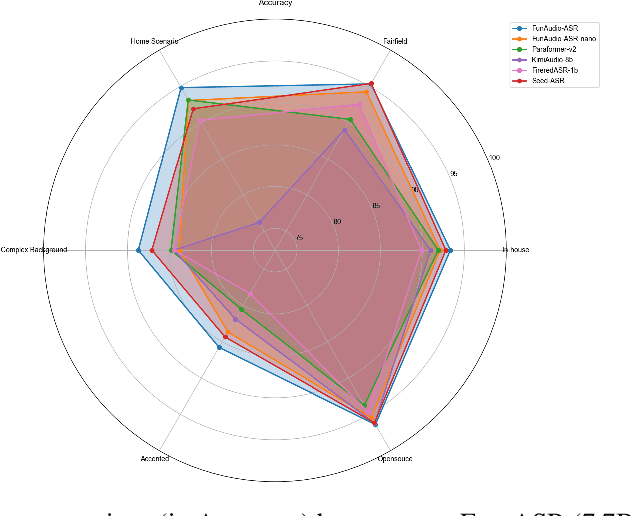

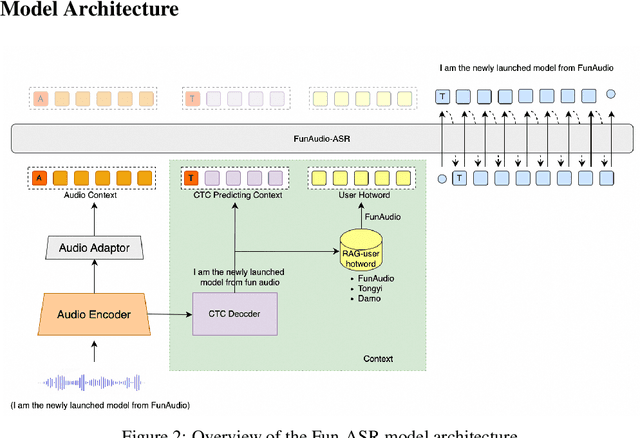

Abstract:In recent years, automatic speech recognition (ASR) has witnessed transformative advancements driven by three complementary paradigms: data scaling, model size scaling, and deep integration with large language models (LLMs). However, LLMs are prone to hallucination, which can significantly degrade user experience in real-world ASR applications. In this paper, we present FunAudio-ASR, a large-scale, LLM-based ASR system that synergistically combines massive data, large model capacity, LLM integration, and reinforcement learning to achieve state-of-the-art performance across diverse and complex speech recognition scenarios. Moreover, FunAudio-ASR is specifically optimized for practical deployment, with enhancements in streaming capability, noise robustness, code-switching, hotword customization, and satisfying other real-world application requirements. Experimental results show that while most LLM-based ASR systems achieve strong performance on open-source benchmarks, they often underperform on real industry evaluation sets. Thanks to production-oriented optimizations, FunAudio-ASR achieves SOTA performance on real application datasets, demonstrating its effectiveness and robustness in practical settings.
Pose-Free 3D Quantitative Phase Imaging of Flowing Cellular Populations
Sep 05, 2025Abstract:High-throughput 3D quantitative phase imaging (QPI) in flow cytometry enables label-free, volumetric characterization of individual cells by reconstructing their refractive index (RI) distributions from multiple viewing angles during flow through microfluidic channels. However, current imaging methods assume that cells undergo uniform, single-axis rotation, which require their poses to be known at each frame. This assumption restricts applicability to near-spherical cells and prevents accurate imaging of irregularly shaped cells with complex rotations. As a result, only a subset of the cellular population can be analyzed, limiting the ability of flow-based assays to perform robust statistical analysis. We introduce OmniFHT, a pose-free 3D RI reconstruction framework that leverages the Fourier diffraction theorem and implicit neural representations (INRs) for high-throughput flow cytometry tomographic imaging. By jointly optimizing each cell's unknown rotational trajectory and volumetric structure under weak scattering assumptions, OmniFHT supports arbitrary cell geometries and multi-axis rotations. Its continuous representation also allows accurate reconstruction from sparsely sampled projections and restricted angular coverage, producing high-fidelity results with as few as 10 views or only 120 degrees of angular range. OmniFHT enables, for the first time, in situ, high-throughput tomographic imaging of entire flowing cell populations, providing a scalable and unbiased solution for label-free morphometric analysis in flow cytometry platforms.
SelfAug: Mitigating Catastrophic Forgetting in Retrieval-Augmented Generation via Distribution Self-Alignment
Sep 04, 2025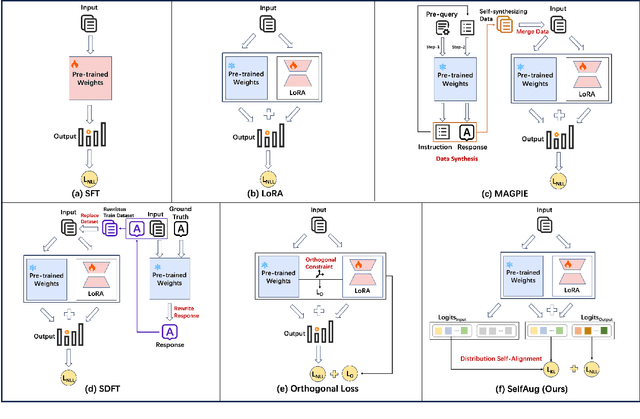
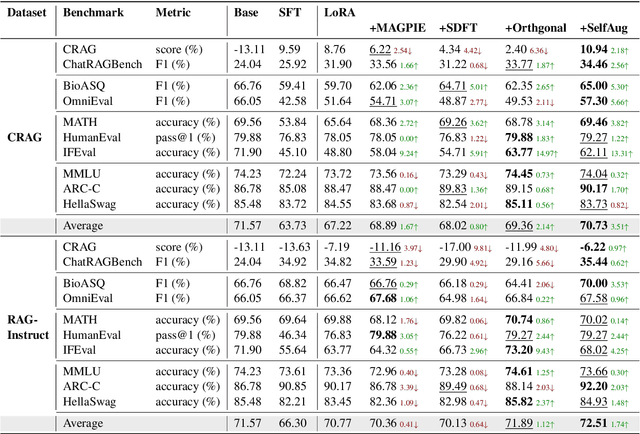
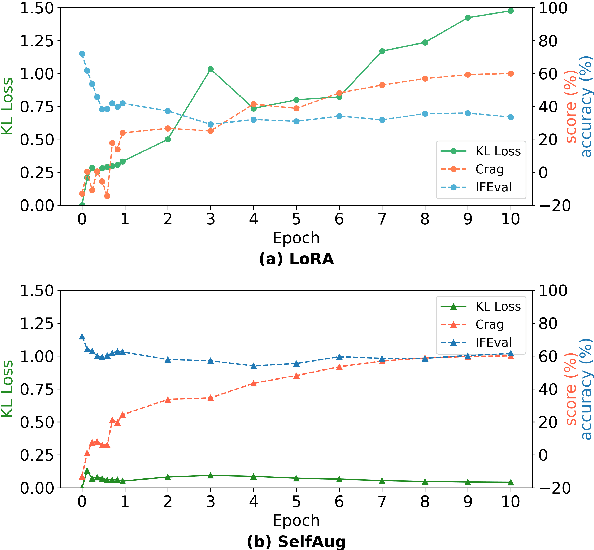
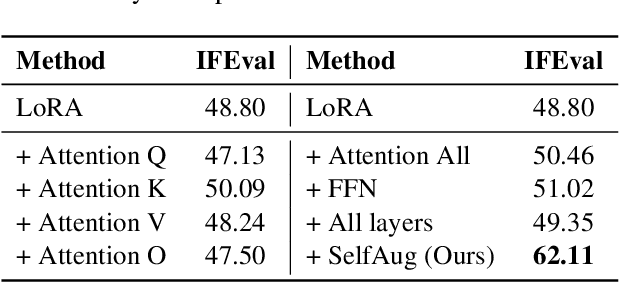
Abstract:Recent advancements in large language models (LLMs) have revolutionized natural language processing through their remarkable capabilities in understanding and executing diverse tasks. While supervised fine-tuning, particularly in Retrieval-Augmented Generation (RAG) scenarios, effectively enhances task-specific performance, it often leads to catastrophic forgetting, where models lose their previously acquired knowledge and general capabilities. Existing solutions either require access to general instruction data or face limitations in preserving the model's original distribution. To overcome these limitations, we propose SelfAug, a self-distribution alignment method that aligns input sequence logits to preserve the model's semantic distribution, thereby mitigating catastrophic forgetting and improving downstream performance. Extensive experiments demonstrate that SelfAug achieves a superior balance between downstream learning and general capability retention. Our comprehensive empirical analysis reveals a direct correlation between distribution shifts and the severity of catastrophic forgetting in RAG scenarios, highlighting how the absence of RAG capabilities in general instruction tuning leads to significant distribution shifts during fine-tuning. Our findings not only advance the understanding of catastrophic forgetting in RAG contexts but also provide a practical solution applicable across diverse fine-tuning scenarios. Our code is publicly available at https://github.com/USTC-StarTeam/SelfAug.
EvolveSignal: A Large Language Model Powered Coding Agent for Discovering Traffic Signal Control Algorithms
Sep 04, 2025Abstract:In traffic engineering, the fixed-time traffic signal control remains widely used for its low cost, stability, and interpretability. However, its design depends on hand-crafted formulas (e.g., Webster) and manual re-timing by engineers to adapt to demand changes, which is labor-intensive and often yields suboptimal results under heterogeneous or congested conditions. This paper introduces the EvolveSignal, a large language models (LLMs) powered coding agent to automatically discover new traffic signal control algorithms. We formulate the problem as program synthesis, where candidate algorithms are represented as Python functions with fixed input-output structures, and iteratively optimized through external evaluations (e.g., a traffic simulator) and evolutionary search. Experiments on a signalized intersection demonstrate that the discovered algorithms outperform Webster's baseline, reducing average delay by 20.1% and average stops by 47.1%. Beyond performance, ablation and incremental analyses reveal that EvolveSignal modifications-such as adjusting cycle length bounds, incorporating right-turn demand, and rescaling green allocations-can offer practically meaningful insights for traffic engineers. This work opens a new research direction by leveraging AI for algorithm design in traffic signal control, bridging program synthesis with transportation engineering.
SAT: Supervisor Regularization and Animation Augmentation for Two-process Monocular Texture 3D Human Reconstruction
Aug 27, 2025


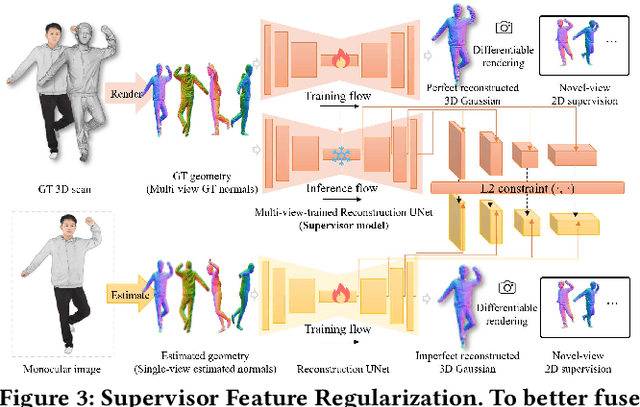
Abstract:Monocular texture 3D human reconstruction aims to create a complete 3D digital avatar from just a single front-view human RGB image. However, the geometric ambiguity inherent in a single 2D image and the scarcity of 3D human training data are the main obstacles limiting progress in this field. To address these issues, current methods employ prior geometric estimation networks to derive various human geometric forms, such as the SMPL model and normal maps. However, they struggle to integrate these modalities effectively, leading to view inconsistencies, such as facial distortions. To this end, we propose a two-process 3D human reconstruction framework, SAT, which seamlessly learns various prior geometries in a unified manner and reconstructs high-quality textured 3D avatars as the final output. To further facilitate geometry learning, we introduce a Supervisor Feature Regularization module. By employing a multi-view network with the same structure to provide intermediate features as training supervision, these varied geometric priors can be better fused. To tackle data scarcity and further improve reconstruction quality, we also propose an Online Animation Augmentation module. By building a one-feed-forward animation network, we augment a massive number of samples from the original 3D human data online for model training. Extensive experiments on two benchmarks show the superiority of our approach compared to state-of-the-art methods.
CausalMACE: Causality Empowered Multi-Agents in Minecraft Cooperative Tasks
Aug 26, 2025Abstract:Minecraft, as an open-world virtual interactive environment, has become a prominent platform for research on agent decision-making and execution. Existing works primarily adopt a single Large Language Model (LLM) agent to complete various in-game tasks. However, for complex tasks requiring lengthy sequences of actions, single-agent approaches often face challenges related to inefficiency and limited fault tolerance. Despite these issues, research on multi-agent collaboration remains scarce. In this paper, we propose CausalMACE, a holistic causality planning framework designed to enhance multi-agent systems, in which we incorporate causality to manage dependencies among subtasks. Technically, our proposed framework introduces two modules: an overarching task graph for global task planning and a causality-based module for dependency management, where inherent rules are adopted to perform causal intervention. Experimental results demonstrate our approach achieves state-of-the-art performance in multi-agent cooperative tasks of Minecraft.
 Add to Chrome
Add to Chrome Add to Firefox
Add to Firefox Add to Edge
Add to Edge